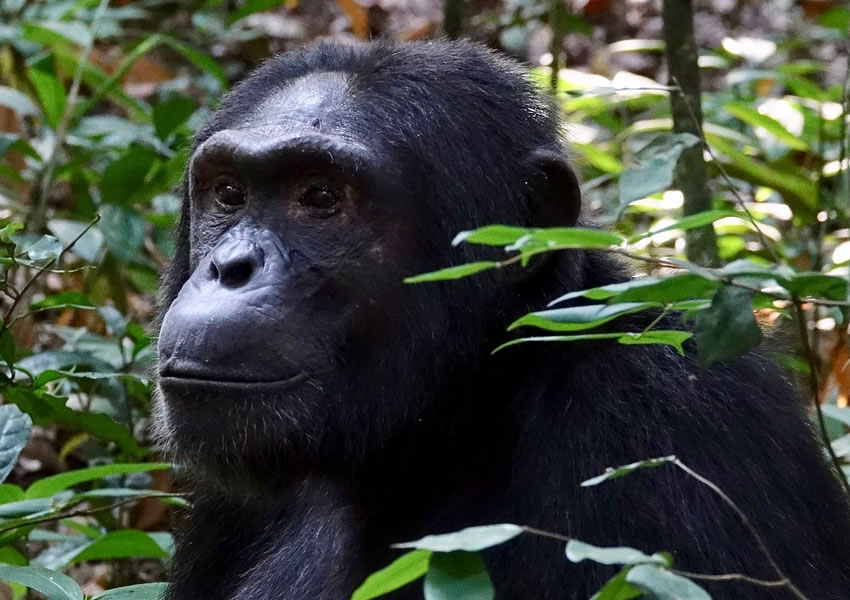Kibale Forest National Park is the most sought park in Uganda for primates, it confirms the say Uganda is a primate destination hosting 13 primate types and the most popular of the national park are chimpanzees, the area contains the largest forest cover between Kamwenge and Kabarole district in the western part of Uganda, trees elevating up to 55m high form some of the loveliest canopies. Kibale forest national park was gazette in 1993 stretching to approximately 795 square kilometers in size and is elevated between 1160m-2607m above sea level, the varied tracts of Kibale forest present a beautiful scenery that is dotted together with crater lakes.
Kibale Forest National Park seems like it’s a world of its own together with the Ndali crater region, you will beam at the sight of the many dotted crater lakes alongside the coolest breeze from the fresh tropical rainforest. The forest is a key attraction to nature lovers, who come insearch of primates, birds, reptiles, amphibians, or butterflies. The vegetation of the national park is composed of forest tree species, climbing and undergrowth plants, and patchy swampy areas. Most parts of the park area are forest, the bio-diverse ecosystem hosts the highest number of primates in Uganda, and there are other animals present in the park-like the African elephants, bush pigs, and forest hogs which are present although they are rarely sighted. Examples of primate types include the Black and white colobus monkey, red-tailed monkey, blue monkey, red colobus monkey, chimpanzee, white-cheeked Monkey, pottos, bush baby, dents Mona monkey, vervet monkey, and the Olive baboons. The park’s population of elephants tends to move between Kibale and the south of Queen Elizabeth national park. The bird life of the Kibale forest national park is also just amazing, over 350 species of birds have been recorded in the conservation area.

The 766 square kilometers national park is a known destination for Chimpanzee tracking, this is the main theme of visit for many travelers, Chimpanzee scientifically is the closest relative to mankind, they are said to share up to 98 % of the human DNA, social and intelligent species, they have the ability to use tools like sticks to collect termites from aunt holes. Chimpanzeeslive in large troops of Up to 100 members led by a male Alpha, tracking these primates is done in two sessions in the morning beginning at 8:00 am east African time and afternoonfrom 2:00 pm respectively, it begins at the Kanyanchu visitor center with a briefing from the park ranger form the Uganda wildlife authority on how to conduct yourself while with the Chimpanzee, heading to the forest there will be all sorts of sweet melodies from birds but one of the chimpanzees is such a loud Charter, they love to play and swing around the trees you will hear them at a distance before meeting them and an hour is allowed while with the Chimpanzee. En route during the hike, you will be chanced to spot other primate species like the Black and white colobus monkeys and the olive baboons. Tracking time lasts for 2-3 hours, the terrain of the park is not as tough as that in the mountain gorilla region, and there is totally no shame in being the last hiker. The speed of the group move depends on that of the last person. The knowledgeable leas guide will ensure to explain to you what the forest has got as you identify more species.
The chimpanzee habituation process is quite the same as the tracking process but this time around you will spend the day with researchers in the forest studying and understanding the process of getting these primates to be used to Human presence. This is a best-fit activity for one who may find just seeing the primates for a short time unsatisfying. Tracking chimpanzeesneed you to have a chimpanzee permit acquired from the Uganda wildlife authority head offices, permits for Chimpanzee tracking are priced at 200 USD for foreign Nonresidents, 150 USD for foreign residents, and 150,000 shillings for East African citizens. The habituation process is priced quite differently from the tracking, 250 USD for foreign nonresidents, 200 USD for foreign residents, and 200,000 Shillings for East African citizens, it is advisable to book these permits prior to the tracking date for convenience and avoid missing out,
Bigodi swamp walk is a must-visit while on safari to Kibale forest national park, the sanctuary is a blessed haven of birds and more to primates, common bird species include the grey crested crane and the great blue turaco, primate species like the colobus monkey, olive baboons, grey checked manga baycan be seen while on a guided nature walk in a swampy area.it is possible to spot other beautiful animals including the antelopes and bush pigs. Visiting the Bigodi is usually done in the afternoon hours. Visiting the Bigodi village is part of the activities to do in the park, they are a calm peaceful team of village mates who are so welcoming right from the adults to the Children. You can visit the Bigodi women’s group whichmakes beautiful crafts for sale as souvenirs.
The park is a great destination for birding safaris, the forest boasts 370 species of birds and most of which recorded are forest birds, the most attractive species in the park are the Green-breasted pita, great blue turaco, Nathan’s francolin, and the blue-headed bee-eater the bird life in the park is best done all year round but best in September, to November, the paradise of birds will showcase endemic forest species of the conservation area.
Crater lakes tour, the park is a close distance to the dotted crater lakes of western Uganda, most of these lakes can be explored on foot, the Kasenda Crater Lake region is composed of over 50 lakes placed in the valleys. The hilly side offers the most angelic views of the continuing ecosystem, example crater lakes include Lake Nyinambuga and Lake Kyaninga.
